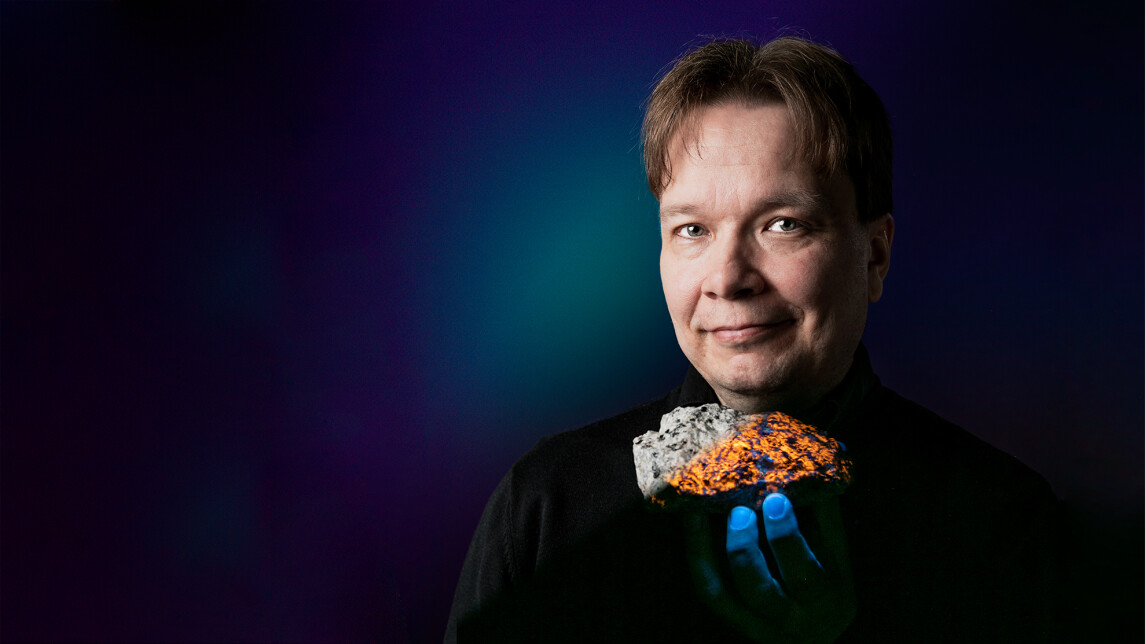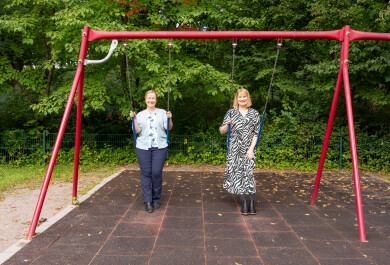Hackmanite is an exceptional mineral – it changes colour and glows in the dark. Research on the material started by chance at the Department of Chemistry of the University of Turku, and researchers there have been astounded by its versatility. Hackmanite’s properties have been tested in the bunkers of the Sweden’s Ministry of Defence and, within a year, the mineral will be sent to space.
Hackmanite has been dubbed a miracle material. The natural mineral changes colour and glows in the dark, and could be used for instance in a lighting fixture, in x-ray imaging, and as a UV radiation detector – and potentially in many other applications as well. The material is environmentally friendly, inexpensive, reusable, and easy to manufacture. Nevertheless, hackmanite is currently used only in jewellery and as a so-called energy crystal, as some people believe in its healing properties. It seems odd that such an exceptional material is virtually unknown to the wider public.
“It is rather strange,” agrees Professor of Intelligent Materials Chemistry Mika Lastusaari, whose research group at the Department of Chemistry of the University of Turku is the only team in the world that currently studies hackmanite.
Even Lastusaari has not studied the mineral for that long – only a decade ago he was unaware of its existence. He heard about it by happenstance at the 2011 mineralogy conference in Potsdam, Germany during the presentation of a French professor. The professor mentioned a mineral that can not only change colour but also revert back to its original colour.
“At that time, I was working with luminescent materials and thought that this mineral has similar properties. It came to mind that hackmanite could benefit my other research,” Lastusaari recounts.
He was interested in studying hackmanite, but the idea was buried under other work for a couple of years. The research started only in 2014, when Lastusaari got Master’s student Isabella Pönkkä to assist him.
“I thought that studying hackmanite would be similar to my other research at the time: observing the material for a little while and then moving on. However, we kept finding new features to study,” says Pönkkä.
"When the researchers noticed hackmanite’s afterglow, they knew they had discovered something completely new"
Lastusaari and Pönkkä started with the research article that the French professor mentioned at the conference in Potsdam. In the article in question, British Chemistry Professor Mark T. Weller and his research group presented a formula for manufacturing synthetic hackmanite. Lastusaari and Pönkkä decided to try and make hackmanite for themselves.
“It is rare that a formula described in a research article works straight away, but that is exactly what happened when we tried it. We found out that synthetic hackmanite is very easy to produce,” says Lastusaari.
The researchers already knew that hackmanite changes colour. They wanted to find out whether they could also make the material glow in the dark. When preparing other luminescent materials, Lastusaari had mixed lanthanides into them to achieve the glow. However, with hackmanite, this method produced no results despite several attempts.
Then, something surprising occurred.
“These won’t glow,” Pönkkä said to Lastusaari after another failed attempt. Lastusaari decided to see the result himself and walked to the laboratory. He didn’t notice the luminescence right away, as the room was dark, and it took some time for his eyes to adjust. Soon, however, he saw that the synthetic hackmanite powder glowed in the dark with a faint white light.
“We were trying to make hackmanite glow green or red with lanthanides, but instead discovered that hackmanite itself has a pale afterglow after the UV light was switched off. We didn’t notice it before as the glow took a surprisingly long time to manifest. Usually, the afterglow appears with a few seconds of the UV exposure, but with hackmanite it took about a minute,” Lastusaari explains.
When the researchers noticed hackmanite’s afterglow, they knew they had discovered something completely new. They decided to develop this property further.
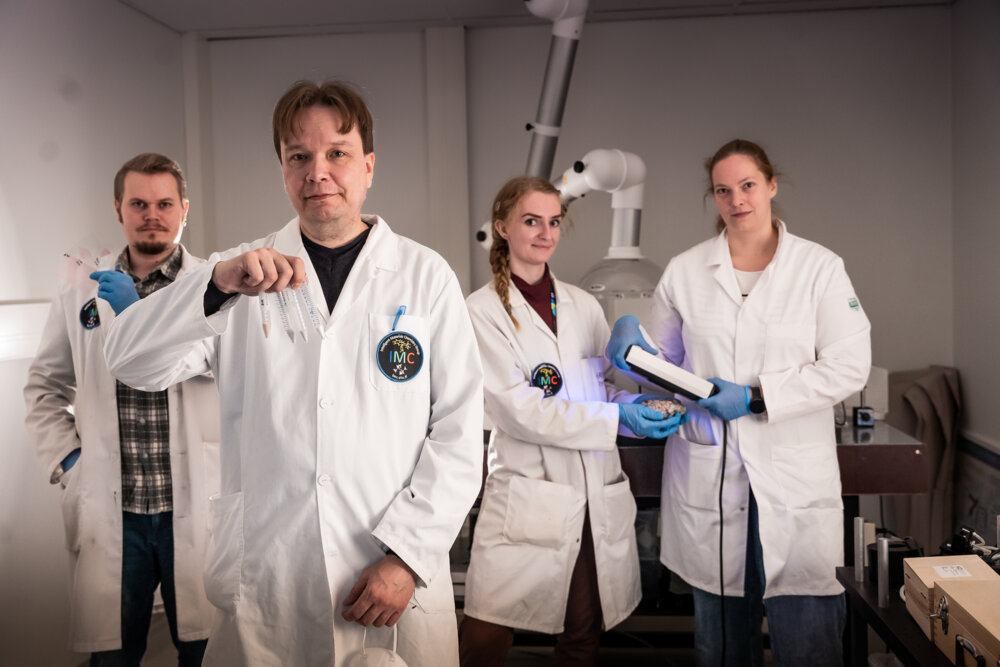
Sami Vuori (on the left), Mika Lastusaari, Hannah Byron and Isabella Pönkkä in the laboratory of the Department of Chemistry.
From a Finnish perspective, the history of hackmanite is particularly interesting, as the mineral was discovered in the Kola Peninsula in Russia by Finnish geologist Victor Hackman (1866–1941), after whom the mineral was named. Chemists studied hackmanite already in the 1940s and 50s, and around that time they learned how to manufacture it synthetically. After that, the mineral has been mainly studied in the 1990s and 2000s by the aforementioned British research group led by Professor Weller. Their publications were significant basic research that did not seek any uses for hackmanite.
Lastusaari’s group, however, is particularly interested in the possible applications of the material. Thanks to their experimental research, hackmanite will most likely soon be known as an extremely versatile miracle material, not just as a colour-changing decorative mineral.
"Thanks to the experimental research of Lastusaari’s group, hackmanite will most likely soon be known as an extremely versatile miracle material, not just as a colour-changing decorative mineral.”
But let’s go back to the beginning of the study.
While watching the hackmanite glow, Lastusaari remembered that he had encountered something similar before. It occurred to him to test whether titanium could be added to the material. The researchers had not previously added titanium to the synthetic mixture they made using Weller’s formula but decided to do so now.
The impact was immediate and the glow grew noticeably stronger. Once the researchers added some lithium, they were able to make the synthetic hackmanite glow in the dark for up to seven hours. This was a significant achievement, but still not long enough that hackmanite could be used, for example, in safety lighting.
“Guides that glow in the dark usually use green light fixtures that glow for 24 hours. The light fixtures contain strontium aluminate mixed with europium and dysprosium whose abundances vary throughout the world. In certain areas, there are rather large deposits of these metals and the countries in these areas can control the market prices,” says Lastusaari.
The inexpensive hackmanite would probably balance the market if the researchers are able to increase its luminescence to the same level as that of strontium aluminate.
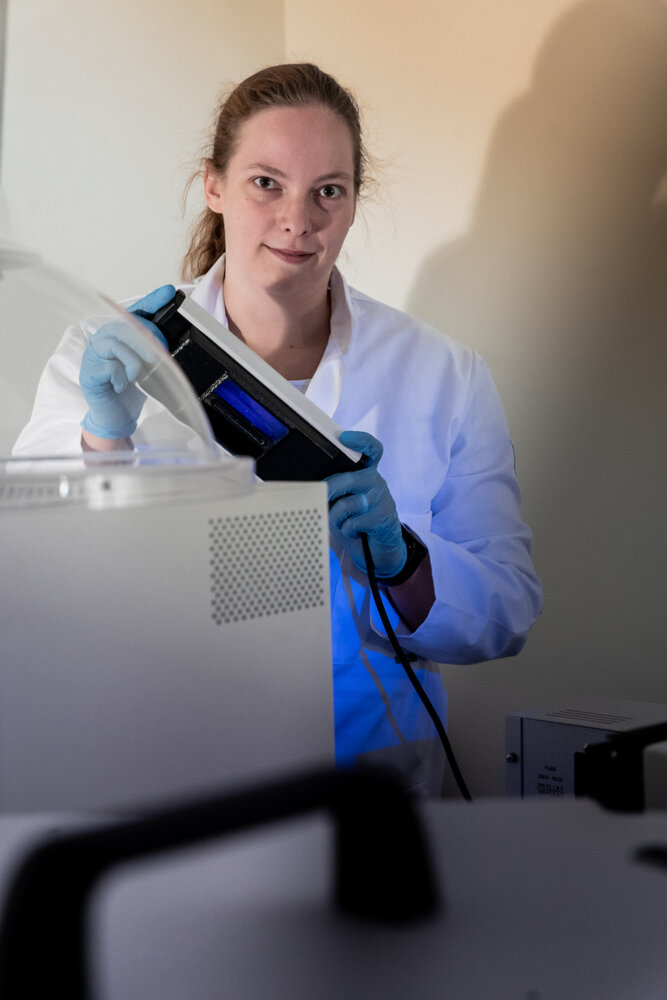
In her company Pure Luminescence Technologies, Isabella Pönkkä is responsible for product development based on hackmanite.
Lastusaari wishes to show how UV radiation affects hackmanite. We are at the new facilities of the Department of Chemistry in the modern Aurum building and step into a windowless research laboratory. There are different sized natural hackmanite rocks as well as synthetic powder on the table. We turn off the lights so that the room is pitch black.
A large hackmanite rock glows blue and orange, which looks wondrous. According to Lastusaari, however, this is not that amazing, as many materials glow with different colours after being exposed to UV radiation. When Lastusaari turns off the UV light, a smaller hackmanite rock keeps glowing with a white light – the professor says that this is truly exceptional. He also shows how the natural mineral and the synthetic powder first turn pink under the UV lamp and how the colour fades under an incandescent lamp.
“Hackmanite is exceptional when compared with other materials as it has so many properties. It shines under UV light, has a faint afterglow, and changes colour. That's three properties in one material which is also environmentally friendly and inexpensive,” Lastusaari summarises.
After the researchers had discovered hackmanite’s glow, they focused on studying its ability to change colour.
Doctoral Researcher Hannah Byron has managed to make hackmanite change to almost any colour.
“Pink, purple, and blue were already familiar to us, but now we can also make hackmanite turn yellow, green, and brown,” Byron recounts.
For her, the day when they discovered the yellow colour in spring 2021 is particularly memorable. Teppo Kreivilä, a Master's student who had been helping Byron with her research, asked whether his hackmanite looked a little yellow after exposure to UV radiation. The yellow tinge was so weak that neither were sure what they were seeing. By measuring the change in colour, Kreivilä confirmed that the hackmanite had, in fact, turned yellow.
“It was a great surprise as we did not expect it to change to yellow,” says Byron.
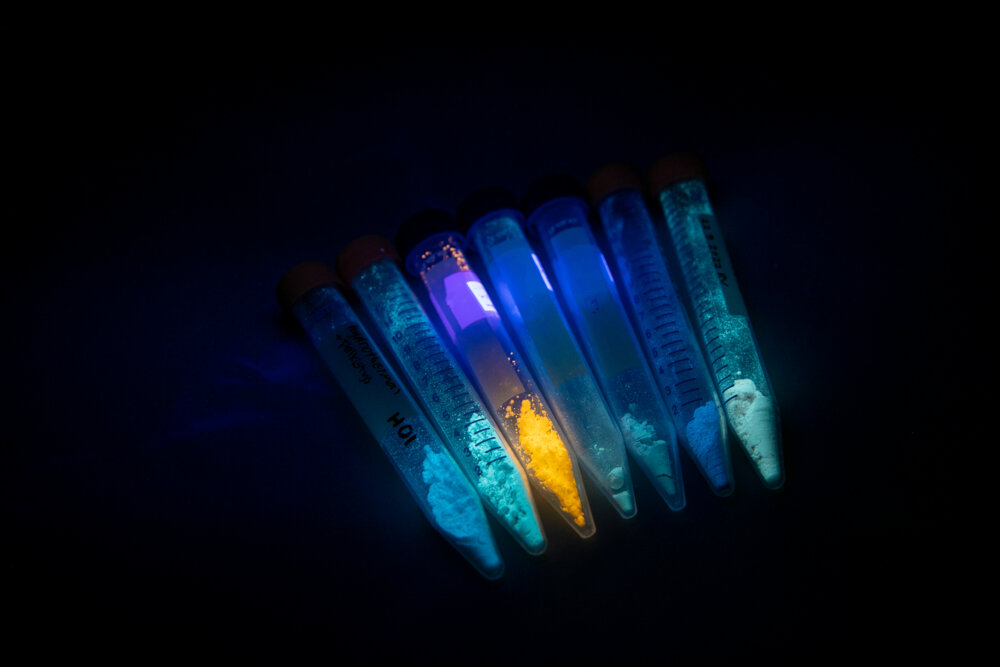
Synthetically manufactured hackmanite is a powder and its properties can be improved from those of the natural mineral.
Sodium sulphate and chloride, as well as zeolite, are needed to manufacture synthetic hackmanite. The ingredients are first ground into a fine powder with a device resembling a mortar, and the powder is then placed into a small container, heated to 850 degrees Celsius, and then left aside to cool. Hackmanite’s colour change can be manipulated by altering the formula or by mixing different hackmanites together.
“As I was studying hackmanite, I noticed that it works similarly to paint. By mixing yellow and blue, I got green hackmanite. With this method, we can achieve almost any colour,” says Byron.
At the moment, she is studying how the different colours and colour-changing hackmanites could be used in versatile applications. One of Byron's ideas is to replace photochromic lenses with hackmanite.
“I have glasses with photochromic lenses that darken in the sunlight. These kinds of lenses usually contain silver, which is considerably more expensive than hackmanite. I’m trying to develop hackmanite into a substance that could be used in photochromic lenses or, for example, in smart windows that change colour to filter out excessive sunlight.”
Another application that Byron is working on is using hackmanite as a UV radiation detector. For this purpose, she has been developing a hackmanite mixture that will change to different colours depending on if it is exposed to either UVA, UVB or UVC radiation, and which will also show the amount of radiation received.
“For example, people could use a hackmanite bracelet which would tell them how much and what kind of radiation they have been exposed to on a sunny day.”
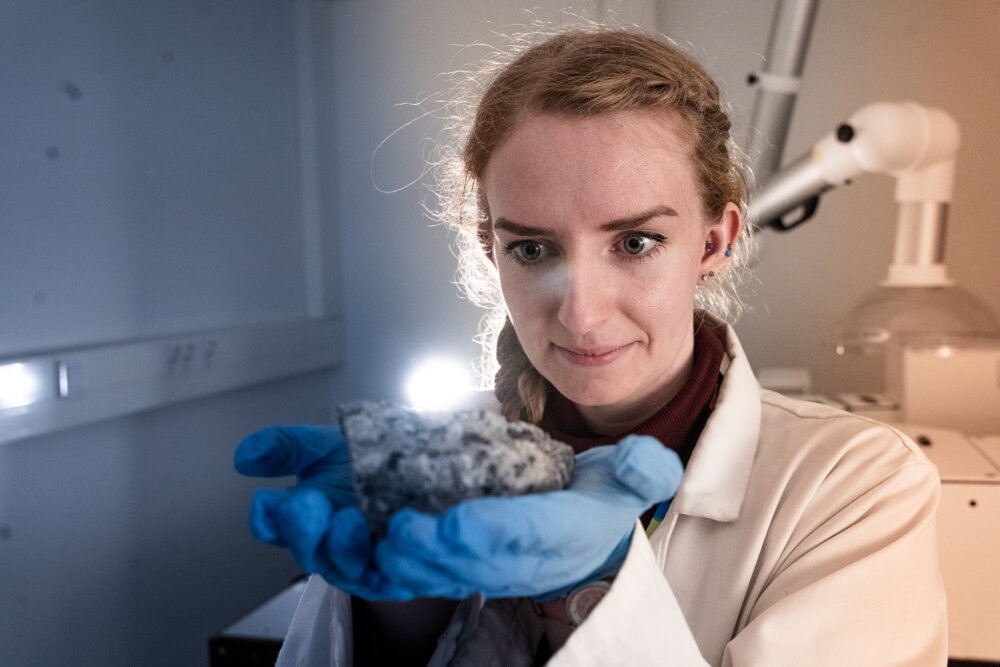
Hannah Byron has been able to make synthetic hackmanite change to almost any colour. In the photo, Byron is holding a natural hackmanite mineral from Canada.
The researchers hope that, in the future, hackmanite will be a familiar material to everyone and used for versatile purposes. From the perspective of global welfare, the most significant application that is currently in sight is X-ray imaging, as the research group has already proven that hackmanite is suitable for this purpose.
Hackmanite is used in X-ray imaging as a sheet on which the X-ray picture is formed. Contrary to the present practices, expensive equipment would not be needed for producing the X-ray picture and analysing it, because the picture can be seen directly from the sheet and saved with a camera. Furthermore, the hackmanite sheet is not disposable, but can be used again and again in imaging. An even greater feature is that the sheet is entirely recyclable.
“At the moment, X-ray imaging is so expensive that only less than half the global population have the chance to get an X-ray if needed. If we could use hackmanite to provide access to X-ray imaging for at least some of the people in the developing countries, it would have a significant impact on people’s well-being. X-ray imaging plays an important role in screening for diseases, as approximately 20–30 percent of diseases can only be diagnosed with imaging,” states Lastusaari.
At the moment, it is not possible to use hackmanite when X-ray imaging people, as the required radiation time is too long. However, product development is well under way: in 2021, Isabella Pönkkä founded a company with two partners to manufacture hackmanite for X-ray imaging and dosimetry.
The company Pure Luminescence Technologies was created in a research project funded by Business Finland, as Pönkkä and her partners noted that there is a demand for a product such as hackmanite.
“We are currently finishing our product development and expect sales within a year. We have contacted several clients and they have been especially interested in hackmanite as a green alternative as well as because of its adaptability. Sometimes the customers suggest new applications in different equipment that we haven't even considered,” Pönkkä explains.
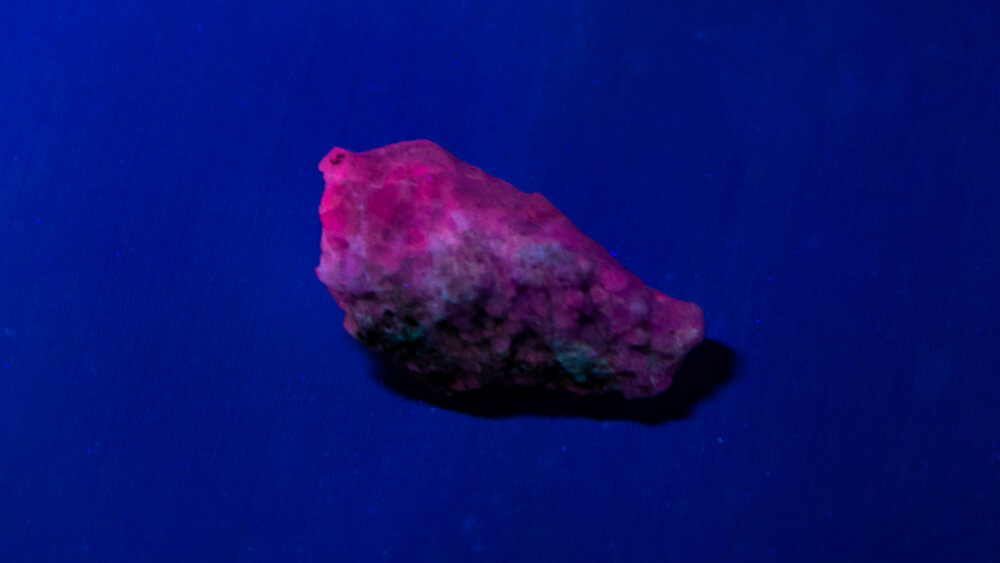
Natural hackmanite minerals are rocks that glow and change colour when exposed to UV radiation.
In 2018, Lastusaari was contacted by the research department of Sweden’s Ministry of Defence as they were interested in hackmanite. Lastusaari suggested collaboration for studying the impact of exposure to radioactive elements’ radiation on hackmanite. For the experiment, Lastusaari, Pönkkä and Doctoral Researcher Sami Vuori travelled to Umeå, where they tested the effect of the radiation in an underground bunker.
“We didn’t have great expectations and the results were rather meagre. The radiation didn’t have much of an effect on hackmanite’s colour,” says Vuori.
”To my knowledge, no other material has a memory trace.”
– Mika Lastusaari
Some months later, the researchers needed once again to test how gamma radiation affects hackmanite. They tested samples at the facilities of the Radiation and Nuclear Safety Authority (STUK) with Finland’s most effective radiation device.
“I took hackmanite samples to Helsinki to STUK’s facilities and set them at varying distances from the radiation device. The samples were left there over the weekend to absorb radiation. When I returned on Monday to check on them, all the samples were pink – the closer they were to the device, the darker the colour,” describes Vuori.
“The experiments eventually showed that hackmanite has a memory trace, which indicates that the material has been exposed to radiation earlier. To my knowledge, no other material has such a feature. It is still a mystery why the samples didn’t change colour in our tests at Umeå,” says Lastusaari.
Gamma and beta radiation are used in improving the shelf life of food and hackmanite that measures the quality and quantity of radiation could be used to assess the amount of radiation the food has been exposed to.
“With colour-changing hackmanite, it would be easy to detect just by visual observation when a food item, such as a potato or onion, has been exposed to a suitable amount of radiation.”
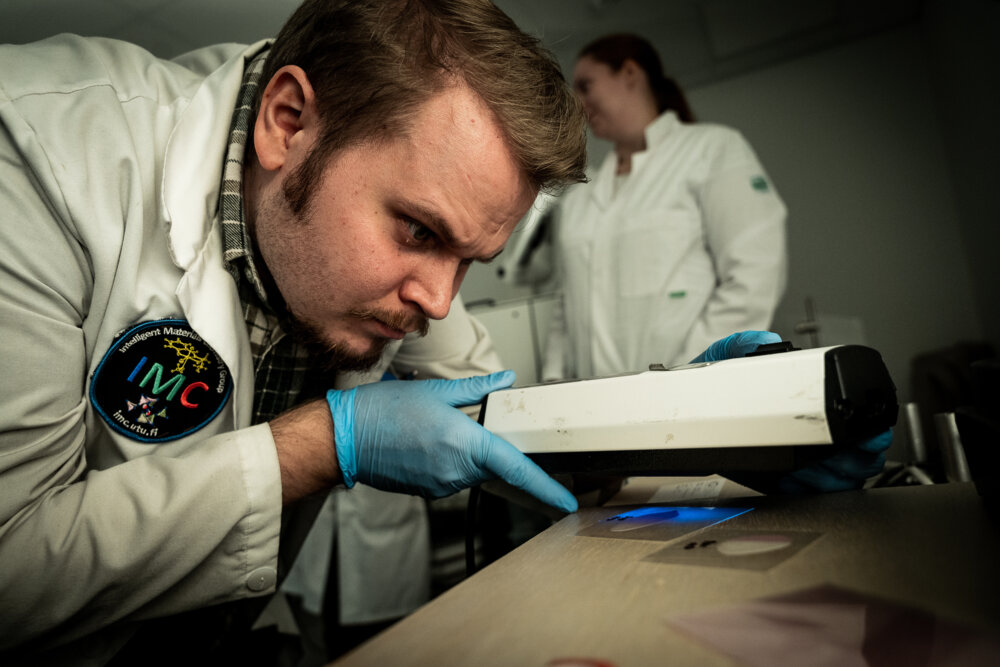
In one of his research projects, Sami Vuori is studying whether hackmanite could be used as film in photography.
If everything goes according to plan, hackmanite’s properties will be soon tested in a very unusual environment – space. Hackmanite-based radiation dosimeters developed by Lastusaari’s group will be delivered to the International Space Station for testing at the beginning of 2024.
In the project funded by the European Space Agency (ESA), the researchers are studying whether hackmanite is suitable for detecting the UV radiation absorbed by different materials in space. Hackmanite is supposed to measure the radiation doses passively without any power consumption.
“At the moment, the space station uses expensive dosimeters that use electricity and are difficult to install. Our goal is to replace these devices with hackmanite,” says Lastusaari.
The trip to space does not require any modifications to make hackmanite more durable, as it endures both extreme heat and cold very well. Instead, the researchers had to work out in which form the hackmanite should be sent to space, as it cannot be used as a powder in such an environment. The solution was a plate made of hackmanite mixed with silicone.
Once the hackmanite samples are delivered to the space station, they will be installed outside the station where they will measure radiation levels. The radiation levels the hackmanite plate is detecting can be checked with a mobile phone app that was developed in collaboration with the Department of Computing of the University of Turku.
“I’m very confident that hackmanite will survive in space,” says Lastusaari.
When you listen to Lastusaari, it quickly becomes clear that we will hear more about hackmanite in the future. Sometimes he stops speaking and says that he would like elaborate on something, but cannot reveal more about on-going research.
“One big thing is coming up in the near future, but we will reveal that later on.”
Text: Jenni Valta
Photos: Hanna Oksanen
Translation: Mari Ratia
